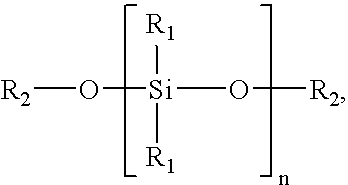Silicone resin containing coating compositions, related coated substrates and methods
a technology of silicon resin and coating composition, applied in the direction of epoxy resin coating, coating, etc., can solve the problems of reduced weatherability and/or stability of coatings, reduced flexibility of coatings,
- Summary
- Abstract
- Description
- Claims
- Application Information
AI Technical Summary
Benefits of technology
Problems solved by technology
Method used
Image
Examples
example 1
[0084] A coating composition was prepared using the components and amounts identified in Table 1. Part A was prepared by combining components 1 through 8 in a one quart can. The can containing the mixture was then placed on a Hockmeyer mixer fitted with a Cowles blade. The pigment was dispersed to 6 hegman fineness of grind and the thixatrope activated by dispersing the mixture at high speed for 30 minutes. During this time the temperature rose from 23° C. to about 75° C. The temperature was then lowered to 55° C. before addition of components 9 through 16. The combined mixture was then mixed until uniform. At this point, component 17 was sifted into the stirred mixture over 15 minutes. Stirring was continued for another 10 minutes after addition of component 17 to ensure uniformity. Part A had a Brookfield viscosity of 6000 cP at 25° C. and a calculated epoxide equivalent weight of 1318.99 grams per equivalent.
[0085] Part B was prepared by combining components 18 through 22 in a o...
example 2
[0086] A coating composition was prepared using the components and amounts identified in Table 2. Part A was prepared by combining components 1 through 8 in a one quart can. The can containing the mixture was then placed on a Hockmeyer mixer fitted with a Cowles blade. The pigment was dispersed to 6 hegman fineness of grind and the thixatrope activated by dispersing the mixture at high speed for 30 minutes. During this time the temperature rose from 23° C. to about 77° C. The temperature was then lowered to 55° C. before addition of components 9 through 16. The combined mixture was then mixed until uniform. At this point, component 17 was sifted into the stirred mixture over 15 minutes. Stirring was continued for another 10 minutes after addition of component 17 to ensure uniformity. Part A had a Brookfield viscosity of 6500 cP at 25° C. and a calculated epoxide equivalent weight of 1218.25 grams per equivalent.
[0087] Part B was prepared by combining components 18 and 19 in a one q...
example 3
[0088] 200.0 grams (0.1516 equivalents) of Example 1, Part A was combined with 29.66 grams (0.1771 equivalents) of Example 1, Part B. The mixture was sprayed on test panels with a Devilbiss air atomizing spray gun. Sand blasted steel panels (4″×7″× 1 / 16″) with a 2-mil profile were used for conicol mandrel elongation. Aluminum panels (3″×6″) were used for QUV-B accelerated weathering tests. Hardiplank cement fiber composite panels (4″×6″) were used for Florida weathering and cyclic QUV-B / Freeze / Cleveland humidity exposure testing. The dry film thickness ranged from 0.004 to 0.005 inches on all test panels.
PUM
| Property | Measurement | Unit |
|---|---|---|
| Percent by mass | aaaaa | aaaaa |
| Percent by mass | aaaaa | aaaaa |
| Percent by mass | aaaaa | aaaaa |
Abstract
Description
Claims
Application Information
 Login to View More
Login to View More - R&D
- Intellectual Property
- Life Sciences
- Materials
- Tech Scout
- Unparalleled Data Quality
- Higher Quality Content
- 60% Fewer Hallucinations
Browse by: Latest US Patents, China's latest patents, Technical Efficacy Thesaurus, Application Domain, Technology Topic, Popular Technical Reports.
© 2025 PatSnap. All rights reserved.Legal|Privacy policy|Modern Slavery Act Transparency Statement|Sitemap|About US| Contact US: help@patsnap.com



